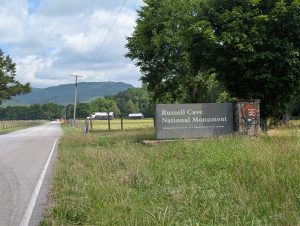
JARRETT GOODMAN
Staff Writer
Located in nearby Jackson County, Alabama, just outside of Bridgeport, lies an ancient and natural wonder etched into the grounds of the Sequatchie Valley.
Russell Cave National Monument, maintained by the National Park Service, is a 310-acre archaeological site rich in historical significance and home to a wide variety of plant and animal life. The cave and its surrounding landscape support a thriving ecosystem.
Russell Cave first gained recognition in 1953 when archaeologists from the Chattanooga Chapter of the Tennessee Archaeological Society were granted permission to explore the site by property owner Oscar Ridley. In 1956, the National Geographic Society purchased the land, and subsequent excavations unearthed nearly two tons of ancient artifacts and burial remains, including human and dog bones, pottery, and weaponry. Among the items discovered was the atlatl, a tool used by Indigenous tribes to hunt large game thousands of years ago.
The cave is estimated to be around 12,000 years old. It is believed that various Native American tribes—from the Archaic to the Mississippian periods—used Russell Cave for purposes including burials, spiritual ceremonies, and as shelter. Many Native American cultures, such as the Cherokee, Chickasaw, and Choctaw, hold caves as sacred spaces. Russell Cave may also have served as a storm shelter or a site for coming-of-age rituals among tribal youth. Seasonal hunting and gathering likely took place in the area, with plants like wild berries and hickory nuts growing nearby during colder months.
More than 130 species of birds, reptiles, and mammals inhabit the monument’s 310 acres, including deer, turtles, and snakes. Unique cave-dwelling creatures—such as trogloxenes, troglophiles, and troglobites—live in the cave’s dark interior. These include the big brown bat, prickly cave crayfish, and southern blind cavefish. Inside, the cave features fascinating rock formations known as speleothems, which come in various shapes and sizes.
Russell Cave National Monument also features the Gilbert Grosvenor Visitor Center, where guests can explore exhibits detailing the site’s archaeological discoveries and the native wildlife of the area. Artifacts, animal facts, furs, and skins are all on display. Two trails lead to the cave: a boardwalk for easier access and a 1.2-mile nature trail through the surrounding woods for those seeking a more immersive experience.
The park is open year-round, seven days a week, from 8 a.m. to 4:30 p.m., with the visitor center closing at 4 p.m. daily. The Gilbert Grosvenor Visitor Center recently played host to its grand opening after closing down for renovations, with the facility now once again open for those seeking to experience and learn about the natural and ancient wonders in which Russell Cave National Monument has to offer.

